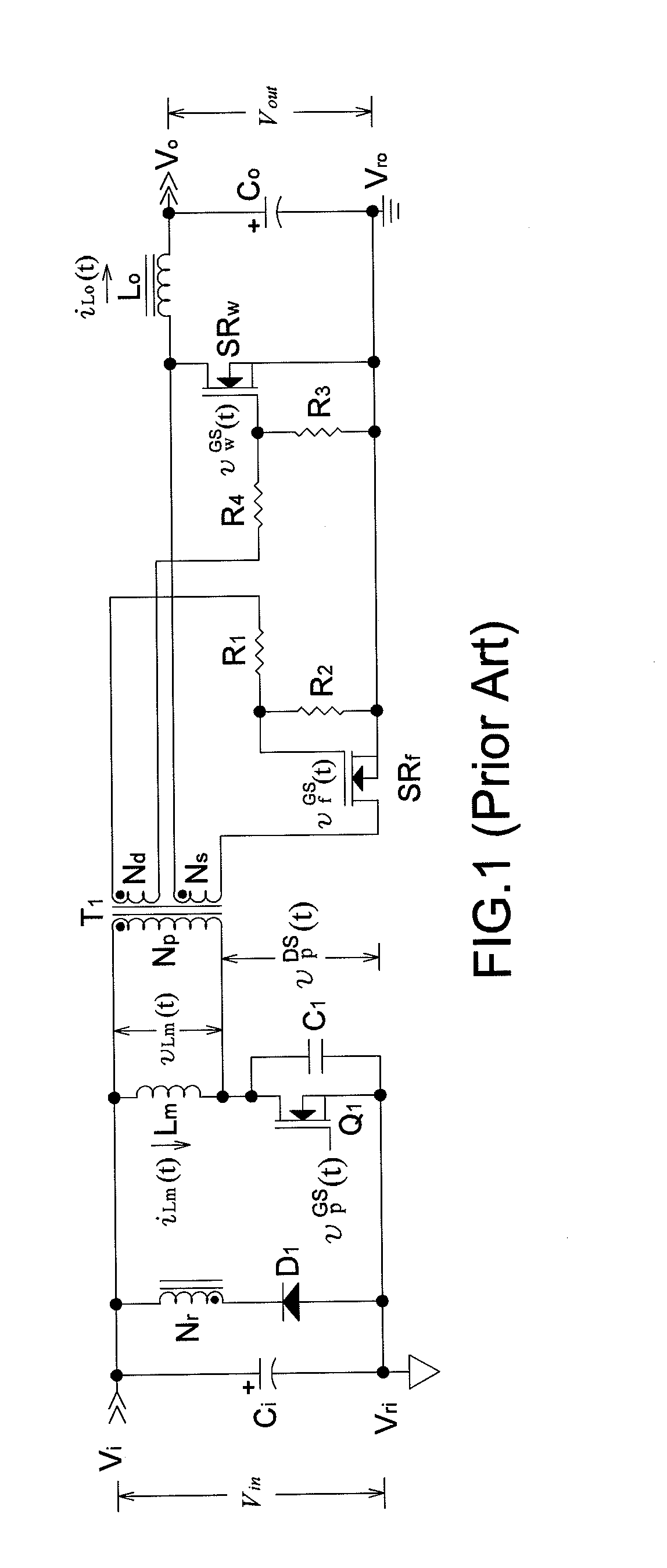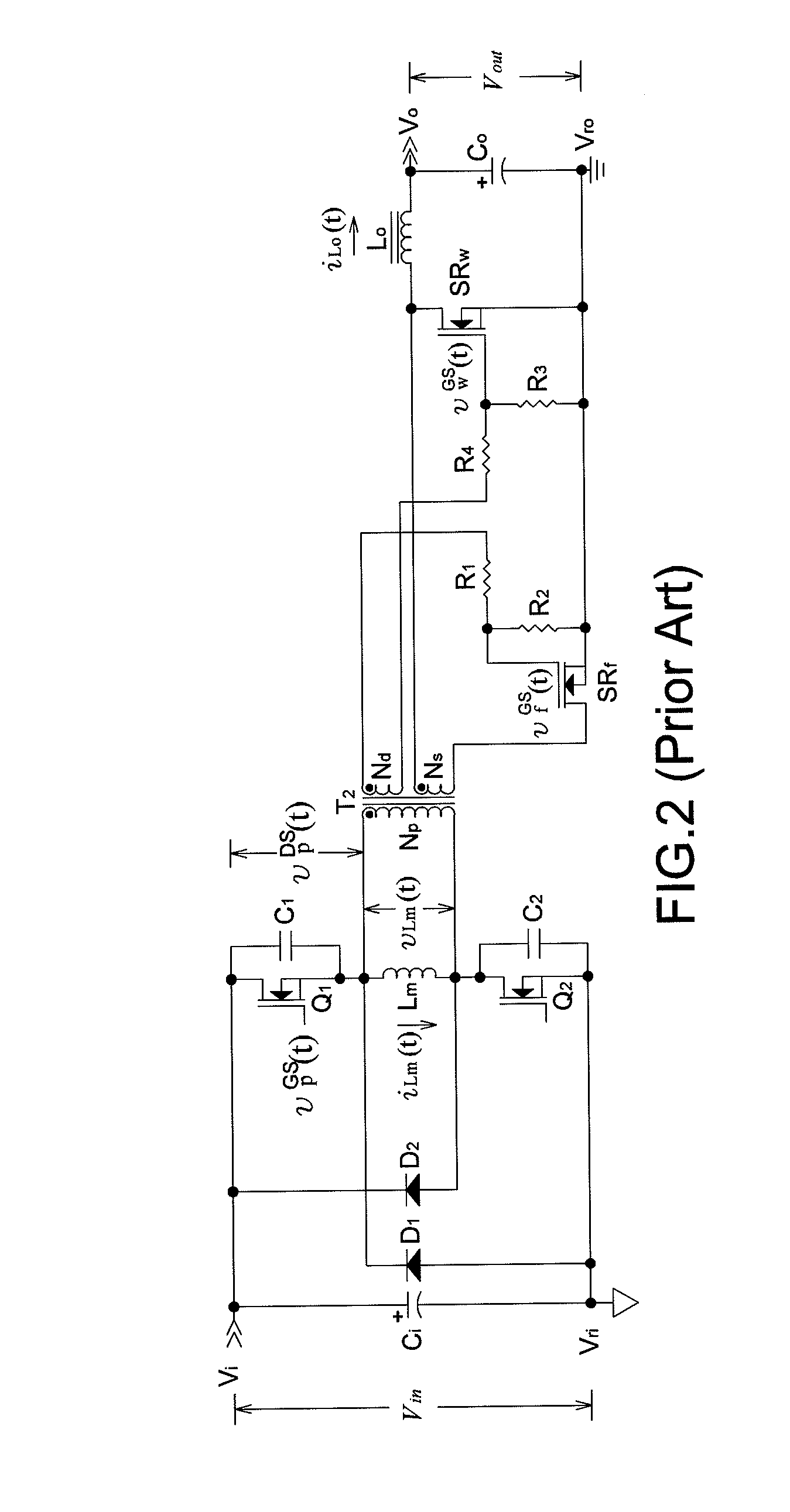Forward converter with secondary side post-regulation and zero voltage switching
a converter and zero voltage technology, applied in the field of forward converters, can solve the problems of high switching losses, inability to achieve the zero voltage switching of the primary side switch transistor, and higher switching losses
- Summary
- Abstract
- Description
- Claims
- Application Information
AI Technical Summary
Benefits of technology
Problems solved by technology
Method used
Image
Examples
fourth embodiment
[0027]FIGS. 4, 5, 7, and 8 respectively depict main frames of a first, a second, a third and, a fourth embodiment based on the present invention. A secondary side error amplification circuit not shown therein detects a sample of the output voltage and compares the sample voltage with a reference voltage to generate an error signal fed back to a secondary side PWM control circuit not shown therein and converted into a PWM driving signal of a secondary side controllable switch for regulating the output voltage.
[0028]If D*pri is a constant primary duty ratio of primary side switch transistors, the output voltage Vout is expressible as
Vout=NsNpDsecVin,
wherein Vin is the input voltage; Np is the turns number of the primary side power winding; Ns is the turns number of the secondary side power winding; and Dsec≦D*pri is a variable secondary duty ratio of a secondary side controllable switch. A variable leading edge blanking time Tblank is expressible as Tblank=(D*pri−Dsec)Ts, wherein Ts i...
second embodiment
[0040]Since vpDS(t0·−)=0 as well as both Q1 and Q2 are switched on again at t=t0·to discharge vpDS(t0·)=0 , the first and the present invention can properly achieve zero voltage switching of primary side switch transistors to reduce switching losses.
[0041]FIG. 9 depicts crucial waveforms of FIG. 8 during a switching period, wherein SRw is driven by Nd.
[0042]During the interval of t0≦t1, vpGS(t) is high; the channels of Q1 and Q2 are both on; vpDS(t)=0; both D1 and D2 are off due to reverse biases; vLm(t)=Vin−2vpDS(t)=Vin; Lm is clamped to Vin and magnetized by iLm(t) flowing through the channel of Q2, Ci, and the channel of Q1; iLm(t) is increasing linearly with a positive slope
iLm(t)t=VinLm;
the induced voltage across Nd makes vfGS(t)>0 and vwGS(t)f is on and the channel of SRw is off. According to vswGS(t) provided by the secondary side PWM control circuit, this interval can be further subdivided into two subintervals:
During the subinterval of t0≦t02, SW switches off its channel to...
PUM
 Login to View More
Login to View More Abstract
Description
Claims
Application Information
 Login to View More
Login to View More - R&D
- Intellectual Property
- Life Sciences
- Materials
- Tech Scout
- Unparalleled Data Quality
- Higher Quality Content
- 60% Fewer Hallucinations
Browse by: Latest US Patents, China's latest patents, Technical Efficacy Thesaurus, Application Domain, Technology Topic, Popular Technical Reports.
© 2025 PatSnap. All rights reserved.Legal|Privacy policy|Modern Slavery Act Transparency Statement|Sitemap|About US| Contact US: help@patsnap.com



